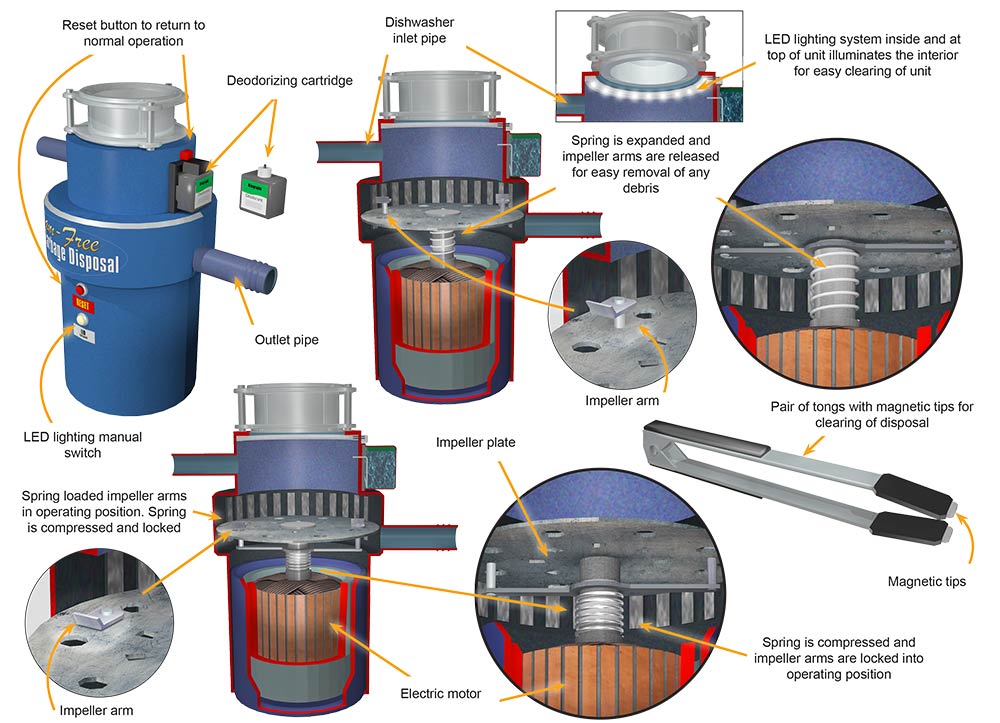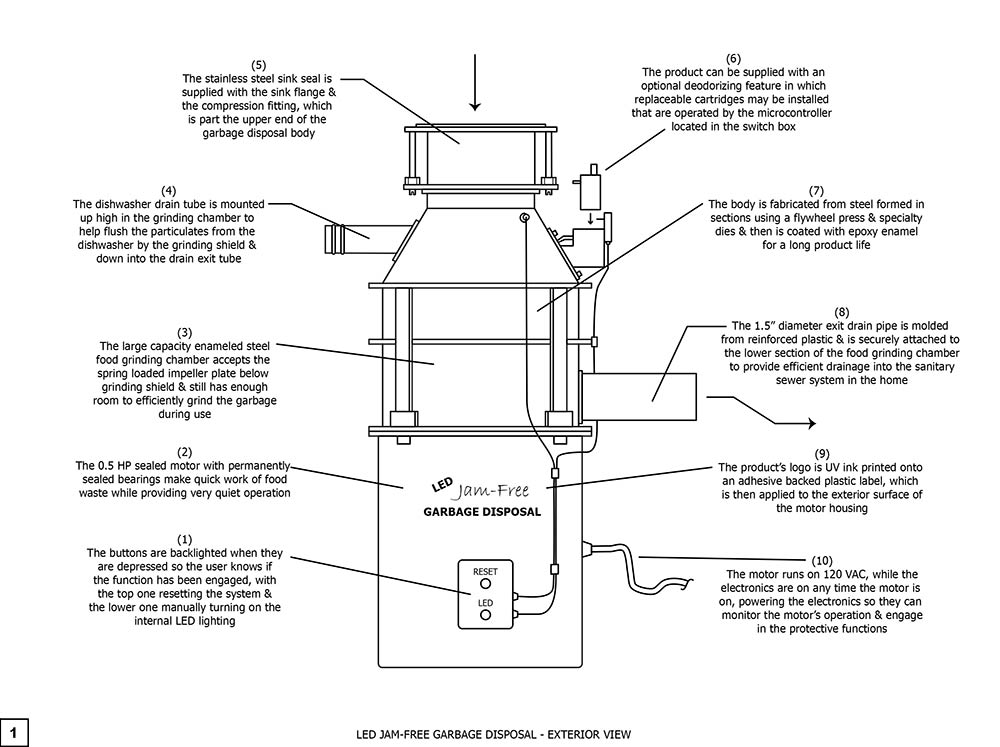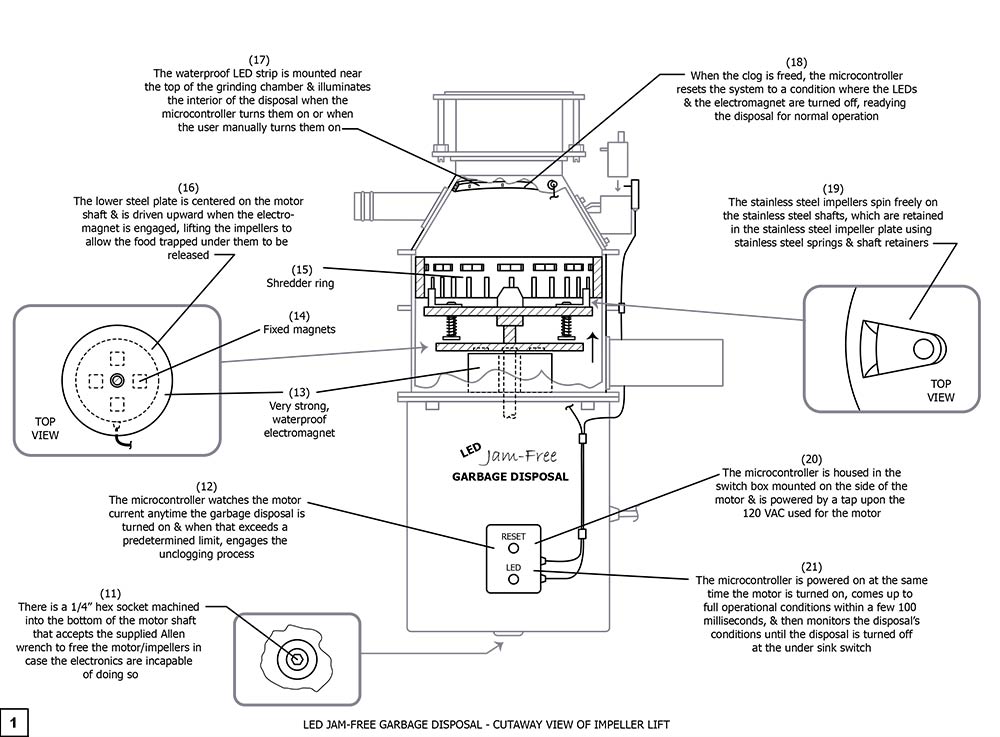
LED Jam-Free Garbage Disposal
DESCRIPTION:
The in-sink garbage disposal was invented in the early part of the twentieth century by inventor John. W. Hammes. Mr. Hammes, an architect by profession, applied for the patent in 1933 and it was issued in 1935. Mr. Hammes created the “InSinkErator” company and placed the product on the market in 1940. The General Electric company disputed Mr. Hammes claim and introduced the “Disposall” also in 1935. Both units install under the kitchen sink and perform the same task. Who invented the device will probably never be resolved and for most people it doesn’t matter.
In 2009, it was estimated that in the United States 50% of homes had disposal units installed compared with the United Kingdom at 6% and only 3% in Canada.
Studies have shown that food scraps comprise of 10 to 20% of household waste and food waste is a problematic component of municipal waste. Food waste is high in water- content and generates methane gas in landfills. The waste is difficult to burn and requires more energy to dispose of than solid waste.
The food disposal unit uses the device to convert food scraps to liquid and utilize the existing sewage system to dispose of the waste. Modern wastewater plants are very successful at processing organic solids and can create products from the waste such as fertilizer and process the methane for energy production.
The typical in-sink garbage disposal has a high-torque and a well-insulated electric motor that drives the impeller, or a circular plate mounted above the motor. The circular plate rotates at high speed and grinds the waste food repeatedly until it is small enough to pass through holes in the plate. Once the waste is small enough to pass through the holes, it is flushed down the drain to the sewage system.
The in-sink garbage disposal units work well most of the time, but like all modern innovations, they are subject to some issues. One of the major issues with garbage disposal units is jamming. Whenever something that the unit is unable to process is placed within the grinding chamber it can become wedged in the rotating surfaces of the unit. Depending on the material that is causing the jam the unit will load up the motor and the unit will switch off to prevent overheating of the motor that can cause failure of the unit. Some items will be ground up with minimal loading of the motor such as pieces of bone or wood. Materials like metal or other surfaces that resist grinding may become lodged in the unit. The only recourse is to reach into the unit to try to locate and extricate the offending material.
The LED Jam-Free Garbage Disposal is an innovative and unique solution to garbage disposal jams. The unit will automatically detect overload of the motor in the event of a jam and switch on the LED lighting system that will illuminate the interior of the grinding chamber. The unit also switches off all power to the motor. The LED Jam- Free Garbage Disposal features a spring-loaded release of the impeller arms that is activated when the unit senses a jam and loading of the motor. The spring is located on the shaft of the motor, and when the motor has an excess load, it will release the impeller arms before switching off the power to the motor. The impeller arms are then easily cleared of any obstruction. The impeller arms are returned to normal when the reset button is pushed. The reset also serves as a manual switch for clearing the unit manually. In addition, a special pair of grasping tongs with magnetic tips is provided to minimize the placing of hands into the disposal. The tongs are sturdy and the magnetic tips will assist in picking up metal particles from the impeller chamber. The LED Jam-Free Garbage Disposal also has a deodorizing cartridge that can be set to spray every time the unit is used or can be activated manually. The LED Jam-Free Garbage Disposal gives the homeowner peace of mind when dealing with materials that find their way into garbage disposals. Creating a simple way to correct issues and improving the home environment.
SPECIFIC, UNIQUE FUNCTIONS OF INVENTION:
- LED lights up the interior of unit
- LED lights up automatically or manually
- Spring loaded impeller release
- Impeller arms are returned to normal when reset button is pushed
- Reset switch operates when impeller arms are reset
- Magnetic tipped tongs for clearing item from unit
- Tongs fit into unit and are designed grasp items
- Deodorizing cartridge operates automatically when unit is used
- Deodorizer can be used manually
- Deodorized cartridge easily replaced when needed
- Constructed of sturdy materials
PRODUCT COMPONENT CLARIFICATION:
The “LED Jam-Free Garbage Disposal” is an innovative kitchen appliance product that has been designed to clear most of its ‘jams’ as they occur, rather than having to reach down into the garbage disposal to clear the impacted material. The disposal uses similar technology and construction as current disposals with the grinding chamber extended about 2” in depth. In this deeper grinding chamber, a waterproof electromagnet is mounted to strongly push up a plate that lifts the impellers off the drive plate to free impacted materials captured below them or between them and the shredder ring. After the clog is freed, the system is reset by the microprocessor control to the normal operating conditions. If the system is stalled out, the internal LED strip is turned on so the user can see within the grinding chamber to remove any loosened yet captured materials and remove them with the magnetic tipped tongs supplied with the disposal.
Currently, if the garbage disposal gets clogged up and ceases to operate, the user has to stick their hand down into the grinding chamber and feel around to find the impacted material restricting the impeller drive plate from turning. This is a messy task, and if all the safety precautions are not taken, can be injurious to the user. Sometimes the jam is so severe, the disposal cannot be freed and must be removed from the sink to be freed or replaced.
The “LED Jam-Free Garbage Disposal” resolves most of these problems by monitoring the motor current and when it starts to increase due to a clogging action, the microcontroller takes steps to release the ‘jam’ before it becomes fully involved and stops the disposal rotation. These steps are, but not limited to, the following:
- The motor current increases by more than 20%, for example.
- The microcontroller turns on the electromagnet, which in turn raises the lift plate and lifts the
impellers up off the impeller drive plate about 0.5”. This action occurs before the motor rotation stops, allowing the material to be released, ground finely, and flushed down the drain.- This action occurs several times within the start of a clog, freeing it without drama.
- It is anticipated that there will be very few clogs with this feature available and the probability of stoppage virtually nil unless the disposal is used improperly.
- If the clog is so severe that the motor is stopped, the LED strip is turned on and the user can see down into the grinding chamber, allowing removal of the offending material using the supplied, magnetic tipped tongs.
- The power to the system is left on and the microcontroller interrupts the motor current, preventing it from inadvertently starting while the clearing operation is underway.
- After removal of the impacted material, the system reset button is pressed and the microcontroller allows the current to the motor to resume.
- If this clears the clog and allows the system to operate, the microcontroller resets the system to normal operation and turns off the LED lighting.
- If the removal of the impacted material does not release the system, then the lower end of the shaft is machined to accept a 1⁄4” Allen wrench, which can be used to wiggle the motor shaft back and forth to clear the jam.
- The power to the system is left on and the microcontroller interrupts the motorcurrent, preventing it from inadvertently starting while the clearing operation is underway.
- After freeing the motor jam and the removal of the impacted material, the system reset button is pressed and the microcontroller allows the current to the motor to resume.
- If this clears the clog and allows the system to operate, the microcontroller resets the system to normal operation and turns off the LED lighting.
The garbage disposal if fabricated in the normal fashion. These standard methods and materials are, but not limited to, as follows.
| Basic construction item | Specification |
|---|---|
| Housing | Steel with enamel finish |
| Internal grinding components | All type 316 stainless steel |
| Motor | 1⁄2 horsepower, single phase, 120VAC, 1725 rpm |
| Amps, AC | 7.0 Amps |
| Drain connection | 1 1⁄2” diameter FR Plastic |
| Dishwasher connection | 3⁄4” diameter FR Plastic |
| Sink opening | 3 1⁄2” diameter |
| Includes | Stainless steel sink flange & Allen wrench |
| Type of use | Residential |
There are several additions to make this system work. These are, but not limited to, the following.
The external switch housing: The switch and electronics protective housing is injection molded from polycarbonate ABS plastic. This plastic is very durable, is highly resistant to impacts and household chemicals, and is typically used in this type of application. The housings can be supplied in almost any vibrant color, so a distinctive color may be chosen to enhance the product recognition factor. This housing is mounted on the side of the motor housing and is wired appropriately. The switches used are backlighted tactile membrane units, which are sealed and bounce resistant.
The printed circuit board (PCB): The PCB for the device is fabricated to the final assembler’s requirements in a world class contract electronic assembler facility. The standard thickness, double sided FR4 circuit board material is populated with surface mounted components where possible. Any through-hole devices are inserted after the surface mounted assembly, soldering, and cleaning. Both circuit boards are designed to have all the components oriented so they can be mounted with the LED illuminators projecting out of the lenses mounted in the housings. After assembly, the PCBs are protected with a moisture adsorption preventive conformal coating.
- The computer: This is a 32 bit RISC, solitary chip microcontroller operating at 50 MHz. It has no onboard memory but is supplied with 8 MB flash and 1 MB SRAM, which can be increased through the use of larger external sources if more memory is required. This controller uses various drivers to engage various operations in the system. The firmware is fixed at the moment of manufacture and cannot be upgraded in the field. The computer has a current sensor in the input power line to the drive motor and monitors the current draw of the motor. When the current exceeds the typical use limits, the impeller lift plate system is activated to resolve the clogging action and return the motor current to typical ranges.
The LEDs: These low current LED devices are turned on using a remote LED driver controlled by the computer. They illuminate the interior of the grinding chamber, are protected from flying object damage using a transparent polypropylene exterior, and are water proof.
The electromagnet impeller lift assembly: This is a commercially available iron cored electromagnet with multiple winds of copper wire. The electromagnet is coated with waterproof resin and the magnetic field is created with power sent to the core by the microcontroller. The magnetic field is oriented to push upon the same polarity field in the imbedded neodymium permanent magnets in the bottom of the impeller lift plate. The 3 watt field generates up to 50 pounds of lift for the impeller plate compressing the impeller springs to lift them up off the plate. When the field is allowed to collapse, the impeller lift pate is forced back down to gently pull the impellers against the drive plate. The field can be pulsed and create up and down movement in the impellers that will clear most clogs before they get fully established.
The LED Jam-Free Garbage Disposal is designed to be aesthetic and effective in the application. The relative ease of manufacture and the moderately inexpensive components provide good marketability for the manufacturer. The user benefits from clog free operation with no hands required inside to free the disposal, which should provide considerable market interest in the product.
The invention is illustrated in the following drawings of the essential points as explained to us in the documentation.

Drawing 1, Block 1: LED Jam-Free Garbage Disposal – Exterior View
(1) The buttons are backlighted when they are depressed so the user knows if the function has been engaged, with the top one resetting the system and the lower one manually turning on the internal LED lighting.
(2) The 0.5 HP sealed motor with permanently sealed bearing make quick work of food waste while providing very quiet operation.
(3) The large capacity enameled steel food grinding chamber accepts the spring loaded impeller plate below the grinding shield and still has enough room to grind the garbage during use.
(4) The dishwasher drain tube is mounted up high in the grinding chamber to help flush the particulates from the dishwasher by the grinding shield and down into the drain exit tube.
(5) The stainless steel sink seal is supplied with the sink flange and the compression fitting, which is the upper end of the garbage disposal body.
(6) The product can be supplied with an optional deodorizing feature in which replaceable cartridges may be installed that are operated by the microcontroller located in the switch box.
(7) The body is fabricated from steel formed in sections using a flywheel press and specialty dies and then is coated with epoxy enamel for a long product life.
(8) The 1.5” diameter exit drain pipe is molded from reinforced plastic and is securely attached to the lower section of the food grinding chamber to provide efficient drainage into the sanitary sewer system in the home.
(9) The product’s logo is UV ink printed onto an adhesive backed plastic label, which is then applied to exterior surface of the motor housing. The logo can be as shown or adjusted by the licensing manufacturer to meet their product concept.
(10) The motor runs on 120 VAC, while the electronics are on any time the motor is on, powering the electronics so they can monitor the motor’s operation and engage the protective functions.

Drawing 2, Block 1: LED Jam-Free Garbage Disposal – Cutaway View OF Impeller Lift
(11) There is a 1⁄4” hex socket machined into the bottom of the motor shaft that accepts the supplied Allen wrench to free the motor/impellers in case the electronics are incapable of doing so.
(12) The microcontroller watches the motor current anytime the garbage disposal is turned on and when that limit exceeds a predetermined limit, engages the unclogging process.
(13) Very strong, waterproof, electromagnet.
(14) Fixed magnets.
(15) Shredder ring.
(16) The lower steel plate is centered on the motor shaft and is driven upward when the electromagnet is engaged, lifting the impellers to allow the food trapped under them to be released.
(17) The waterproof LED strip is mounted near the top of the grinding chamber and illuminates the interior of the disposal when the microcontroller turns them on or when the user manually turns them on.
(18) When the clog is freed, the microcontroller resets the system to a condition where the LEDs and electromagnet is turned off, readying the disposal for normal operation.
(19) The stainless steel impellers spin freely on the stainless steel shafts, which are retained in the stainless steel impeller plate using stainless steel springs and shaft retainers.
(20) The microcontroller is housed in the switch box mounted in the side of the motor and is powered by a tap upon the 120VAC used for the motor. The electronics takes the 120 VAC and uses an on board power supply to make the 5VDC for the electronics operation.
(21) The microcontroller on powered on at the same time the motor is turned on, comes up to full operational conditions within a few hundred milliseconds and then monitors the disposal’s conditions until the disposal is turned off at the under sink switch
Although a single embodiment of the invention has been illustrated in the accompanying drawings and described in the above detailed description, it will be understood that the invention is not limited to the embodiment developed herein, but is capable of numerous rearrangements, modifications, substitutions of parts and elements without departing from the spirit and scope of the invention.
This document has been prepared for the manufacturer’s elucidation. The manufacturer’s decision makers should consider this product for licensing (providing intellectual property protection for their sales of the product in return for a royalty payment for a period of years) or an outright purchase of the patent for a negotiated fee. The inventor and her team are standing by to consider offers for licensing or outright purchase of the patent.


